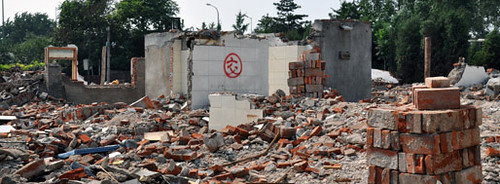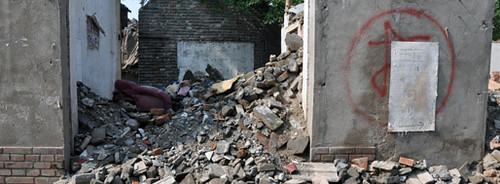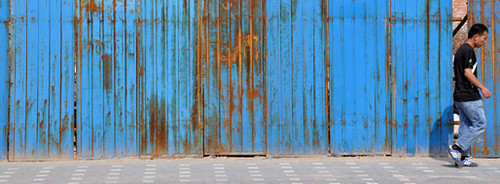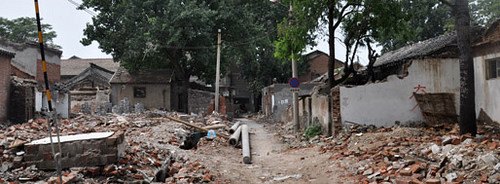Hutong Cemeteries

[Image: Area around Gulou Dajie subway station | July 14, 2009, Photo by Bert de Muynck.]
A nice three-part series of posts over at Moving Cities draws our attention once again to the rapid disappearance of the Hutongs in Beijing, which seems to have somewhat vanished from the conversation now that the attention brought to them during the Olympic Games has elapsed.
What is a follow up to a previous publication written by Bert de Muynck for MUDOT, (Making mince meat of memory) he asks, “where have the memory masochists gone to?” and why has “the topic of the disappearance of the hutongs disappeared from the agenda. Are the hutongs the victims of their own hype? If we don’t debate it, does it mean we don’t care (and we actually have never cared about it)?”
It’s a cogent comparison I think, the disappearance of attention to the hutongs with their own physical demolition. Might we take it a step further and ask, has the media attention in some way been equally demolished? Or, has the effort to preserve the hutongs in Beijing merely given in and lost will to resist, and thus the scrutiny over them has followed? What is the real connection between the actual disappearance of the hutongs and the media attention that once hawked over the process?
In some ways, I wonder, if even this post-Olympic phase is where the real damage is done, not only in physical terms to the neighborhoods but the real damage to memory as the public enters into a larger collective amnesia of the entire history of the hutongs.


Included are some great photographs Bert has taken of a specific area that is being diced for the construction of the Gulou Dajie subway station; corridors of historic rubble, atomized memory bits, the urban masks of blue walls (which we have written about ourselves here), homes perforated by what almost looks like concentrated blasts of urban warfare, tractors ripping through the alleys like robotic droogs on a rampage, furniture left on the street as if abandoned elderly crouched and waiting to die alone.

In an email exchange with Bert, I asked him: what if any positive memory archival projects are standing strong in all of this? Is there a sense that the Chinese are forfeiting a big part of themselves, or are there new forms of activism desperately trying to render something positive out of the rubble? From an architectural historian perspective, what strategies of archive could be discovered in this scenario? Is there something experimental that could come out of the demolitions?


In part 2 Bert discusses some of the preservation efforts that are happening there, for example, "punctual preservation" whereby single elements are somewhat stored in the new structures. In the final 3rd part, he looks at what he calls “the celebration of the collapse of pre-Olympic “Beijing Hutong Preservation”-bubble” and details the “phenomenon of the hutong “fake-overs” and “paper preservation”.

It is of course a very interesting topic for various reasons and from various angles. One could easily put this in perspective of New Orleans today, or Flint, Detroit, or even parts of downtown San Francisco for that matter, Tijuana, Gaza, Rio, the greater foreclosure crisis -- you name it. Redevelopment, or, the tragic lacks of proper redevelopment in some cases, are leaving places across the world in semi-erased states of manmade disaster everywhere, whether they're ordered by the evaporation of capital or are completely obliterated by the poorest of responses to natural disaster and war, the politics of redevelopment are leaving marks just as quickly as they are taking old historic marks away from the landscapes of memory. Glad someone is keeping watch.
Thanks Bert for pointing us that way!
(All Images: Area around Gulou Dajie subway station | July 14, 2009, by Bert de Muynck.)







1 Comments:
This sort of churn was typical of NYC's growth until fairly recently, representing an unsentimental view of physical infrastructure that fostered the frantic growth and amazing urban density that made this place one of the premeinant world cities. The images out of China today mirror those from the 5-boroughs from the 1910s, and to the degree that its saving whatever natural landscape is left from further encroachment by the disgusting scrim of exurban sprawl (ie the californication of the world), should be applauded.
But, in NYC, the rise of this embalming spirit, starting with perhaps a genuine greivance (the razing of Penn Station), has expanded to become a protectionist nimbyism that sees precious history in every portion of the city that has merely managed to survive 40 years, and ultimately seeks to transform an environment that had previously encouraged density into one that seeks a flattening, the deflating ooze that quickly becomes, say, long island or forth worth or san jose or any other place where the landscape was and continues to be smothered for cars, strip malls, and 1/4 acre lots.
Until humanity figures out how to radically decrease our populations, our only hope for maintaining any shred of the natural world is urban density, and this necessarily means the constant refashioning of urban fabric into denser arrangements. In China's case, it appears the displacements have been done with little justice to the affected individuals, and if so, will likely haunt them.
If, however, these increases in density come at a cost to physical remenants of human history, so be it; its ultimately a cheaper bill than seeing the last bits of the natural world paved over for the burbs.
Post a Comment
<< Home